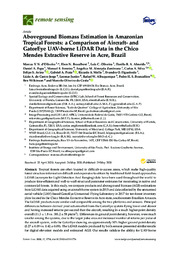Aboveground biomass estimation in Amazonian Tropical Forests: a comparison of aircraft- and GatorEye UAV- borne LiDAR data in the Chico Mendes Extractive Reserve in Acre, Brazil.
Aboveground biomass estimation in Amazonian Tropical Forests: a comparison of aircraft- and GatorEye UAV- borne LiDAR data in the Chico Mendes Extractive Reserve in Acre, Brazil.
Author(s): OLIVEIRA, M. V. N. d'; BROADBENT, E. N.; OLIVEIRA, L. C. de; ALMEIDA, D. R. A.; PAPA, D. de A.; FERREIRA, M. E.; ZAMBRANO, A. M. A.; SILVA, C. A.; AVINO, F. S.; PRATA, G. A.; MELLO, R. A.; FIGUEIREDO, E. O.; JORGE, L. A. de C.; JUNIOR, L.; ALBUQUERQUE, R. W.; BRANCALION, P. H. S.; WILKINSON, B.; COSTA, M. O. da
Summary: Tropical forests are often located in dicult-to-access areas, which make high-quality forest structure information dicult and expensive to obtain by traditional field-based approaches. LiDAR (acronym for Light Detection And Ranging) data have been used throughout the world to produce time-ecient and wall-to-wall structural parameter estimates for monitoring in native and commercial forests. In this study, we compare products and aboveground biomass (AGB) estimations from LiDAR data acquired using an aircraft-borne system in 2015 and data collected by the unmanned aerial vehicle (UAV)-based GatorEye Unmanned Flying Laboratory in 2017 for ten forest inventory plots located in the Chico Mendes Extractive Reserve in Acre state, southwestern Brazilian Amazon. The LiDAR products were similar and comparable among the two platforms and sensors. Principal dierences between derived products resulted from the GatorEye system flying lower and slower and having increased returns per second than the aircraft, resulting in a much higher point density overall (11.3 1.8 vs. 381.2 58 pts/m2). Dierences in ground point density, however, were much smaller among the systems, due to the larger pulse area and increased number of returns per pulse of the aircraft system, with the GatorEye showing an approximately 50% higher ground point density (0.27 0.09 vs. 0.42 0.09). The LiDAR models produced by both sensors presented similar results for digital elevation models and estimated AGB. Our results validate the ability for UAV-borne LiDAR sensors to accurately quantify AGB in dense high-leaf-area tropical forests in the Amazon. We also highlight new possibilities using the dense point clouds of UAV-borne systems for analyses of detailed crown structure and leaf area density distribution of the forest interior.
Publication year: 2020
Types of publication: Journal article
Unit: Embrapa Acre
Keywords: Aboveground biomass, Acre, Amazonia Occidental, Amazônia Ocidental, Biomassa aérea, Bosques tropicales, Drone, Estimativa, Floresta Tropical, Forest inventory, GatorEye, Inventario forestal, Inventário Florestal, Lidar, Monitoreo, Monitoring, RESEX Chico Mendes, Raio Laser, Reconhecimento Florestal, Remote sensing, Sensoriamento Remoto, Seringal Filipinas (AC), Teledetección, Tropical forests, Unmanned aerial vehicles, Vehículos aéreos no tripulados, Western Amazon
Observation
Some of Embrapa's publications are published as ePub files. To read them, use or download one of the following free software options to your computer or mobile device. Android: Google Play Books; IOS: iBooks; Windows and Linux: Calibre.
Access other publications
Access the Agricultural Research Database (BDPA) to consult Embrapa's full library collection and records.
Visit Embrapa Bookstore to purchase books and other publications sold by Embrapa.

